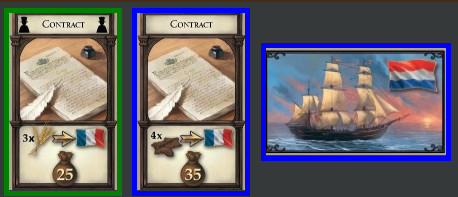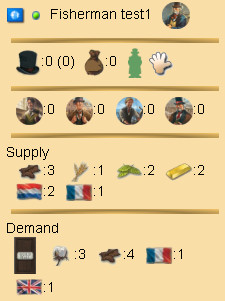Set Up
• Place the game boards in the middle of the table.
• Sort the cards by game board. Shuffle each deck and place them in a face down deck on the talon field of the corresponding game board.
Special rule for two player games:
Draw six cards from each deck and place these cards (unseen) in the box. These cards won’t be used in this game.
• Draw two cards from each deck and place these cards face up on the two future supply spaces on the corresponding game board.
• Draw a number of cards from each deck and place these cards face up on the current supply spaces on the corresponding game board. The number of cards to draw depends on the number of players in the game:
| Number of players | 2 | 3 | 4 | 5 |
| Cards in the current supply | 2 | 2 | 3 | 4 |
• Shuffle the starting contract cards. Each player gets one card. Return the remaining starting contract cards to the box. These cards aren’t used in this game.
• Place the money in a supply next to the game boards.
• Each players gets $25.
Players must keep their money clearly visible in front of them during the game.
• Each player gets a playing piece in the colour of his choice and places this in front of him.
• Choose a starting player. This player gets the harbour master token. He’ll be the harbour master in the first round.
Game overview
The game is played in rounds. Each round the harbour master chooses one of the four game areas (guildhall, docks, market or bank) and asks the other players in clockwise order (starting with the player left of the harbour master) whether they want to take a card from the current supply of the chosen game area or not. After asking all other players, the harbour master must decide to take a card (if available) or not.
If the harbour master chooses not to take a card in this game area, he chooses another area (not chosen this round) and the procedure above is repeated. If a player takes a card, he must place his playing piece on the space the card is taken from.
Each round a player can take one card only. Once his playing piece is placed on one of the game boards, that player cannot take anymore cards this round. If a player decides not to take a card, he keeps his playing piece and might get the opportunity to take a card from another area this round.
If all other players have taken a card this round, the harbour master must take a card from either the current area or from a game area not chosen this round. He is not allowed to choose from a previously chosen game area or choose another game area and not take a card. If the harbour master can’t or doesn’t want to take a card at this moment he must pass and the round ends.
• Players can only take cards from the current supply (exception: Assistant – see card overview)
• If a player takes a goods, victory point or gold nuggets card, he must pay the costs to the supply.
• Players add all cards taken to their hands and keep these hidden from other players (exception: merchant ships are placed in front of the player.)
*That's not the case in the online implementation as stated above. Only the contract each player has taken at the beginning of the game is hidden.
A round ends when the harbour master takes a card or when no areas are left to choose from. It is possible that not all players take a card each round.
After a round has ended prepare the next round:
• For each game area which has been chosen this round:
› Return the playing pieces to the corresponding players.
› Discard all remaining cards from the current supply on each game board to the corresponding discard pile.
› Move the cards from the future supply to the current supply. Draw one (four player game) or two (five player game) additional cards from the corresponding deck and add these cards face up to the current supply.
If any assistants have been used, more cards must be drawn till current supply is complete according to the original setup for the number of players.
(Clarified by game designers at: BoardGameGeek)
› Draw two cards from each deck and place them face up in the future supply.
• The harbour master token is given to the next player in clockwise order. He’ll be the harbour master in the next round.
Then a new round is played.
At any time during the game, players can fulfil contracts. To fulfil a contract a player must have a contract card, the matching good card(s) and a matching merchant ship card. The player discards these cards and takes the amount of money shown on the contract card from the supply.
Rules for fulfilling contracts:
• It is allowed to fulfil a contract with more goods than needed. The excess goods are lost. No refund is given.
• It is allowed to fulfil multiple contracts of the same destination with one merchant ship card.
• If a player fulfils multiple contracts at once (with the same or different destinations), he may divide the goods on the used goods cards as needed between the contracts. This way he can divide the goods on a card between two or more ships.
Anna has these cards:
Anna can fulfil this contract by discarding the contract, the two goods cards and the merchant ship. She’ll get $35 from the supply.
David has these cards:
He can fulfil three contracts at once. His tobacco will be split among the two contracts. The excess cotton is lost. He’ll get $35 + $15 + $15 = $65 from the supply. All cards used for fulfilling these contracts are discarded.
In a game with four players these are the cards in the Market:
Anna is the harbour master. She decides to go to the market and asks Ben if he wants to take a card from this game area.
He chooses the University and pays $15 to the supply. He puts his playing piece on the space he took the card from and adds the card to his hand. Now Anna asks Cedric. He doesn’t want a card from this game area and keeps his playing piece.
Then David is asked to decide whether or not to take a card from the market. He wants tobacco, but since the card with three tobacco is in the future supply he decides to take the card with one tobacco and pays $2.
Finally Anna may decide to take a card. She doesn’t want any of the cards left in the market and has to choose another game area.
These are the cards in the Docks:
Since both Anna and Cedric didn’t take a card this round (from the market), Anna asks Cedric if he wants to take a card from the docks. He decides to pass again, hoping to get a chance in another game area. But bad luck for him… Anna decides to take a merchant ship. This card costs her no money and she places the card in front of her.
Anna, the harbour master this round, has taken a card. The round ends. Unfortunately for Cedric, he did not get a card this round.
This is the end of the round. The cards in the current supply in the market and the docks are discarded. The current supplies in these game areas are refilled with the cards of the future supply and one card from the deck. Also two new cards for the future supply are drawn. Anna gives the harbour master token to Ben. He’ll be the harbour master in the next round.
Areas:
A: The harbour master can activate areas by clicking the yellow arrow.
In the active area,

is displayed in this position.
In areas that have been already activated this round,

is displayed in this position.
B: The area talon can be clicked and a popup window displays the cards available in the deck.
The number right below the talon card, indicates how many cards are still available in the deck.
C: Future supply cards. On click, a popup displays a maximized image.
If the player can pick up those cards, an icon appears below reminding that an assistant will be spend.
D: Current supply cards. On click, a popup displays a maximized image.
The player can pick up those cards using the merchant icon displayed right below the card.
- In the activated area, cards that can be picked up are surrounded by a blue border,
while cards that cannot be obtained (either because the player cannot afford it or due to lack of assistants)
are surrounded by a red border.
- When a card is picked up by a player, it is replaced for the rest of the round by a playing piece in the player's color.
If the playing piece is clicked, a popup window reveals the card which was taken.
Contracts:
The player can pick up cards from his/her hand. Selected cards are highlighted in a blue border.
Once the highlighted cards are enough to fulfil one or more contracts,
a button appears in the blue ribbon which allows the player to discard the cards and get the money for the contract(s).
According to the game rules, a player can fulfil contracts at any point of the game, even when the game finishes.
Therefore, when the game is finished, a complimentary round is played where all players with enough cards in their hand
are given a last chance to fulfil their contracts.
Player Info Tabs:
These tabs are designed to allow you to see each player's data at a glance.
In the first line, after the player's name, a harbour master icon indicates whether the player is assigned this role for the round.
In the second line, points (end points in parenthesis) and money is displayed. By clicking on the hat, you can see a points analysis for the player.
The playing piece indicates that the player hasn't picked up a card yet in this round. The hand icon reveals the player's hand cards in a popup.
In the third line, from left to right, are the number of assistants, bankers, captains and traders.
In the fourth line, the sum of goods and ships this player has in his hand are displayed.
Note that the number is the sum of all cards in the player's hand.
In the fifth line, the sum of goods and destinations required by the contracts this player has in his hand are displayed.
Again the numbers are the sum of all cards.
If an opponent still has a hidden initial contract in his hand, you will see as a reminder the back of this card at the beginning of the line.